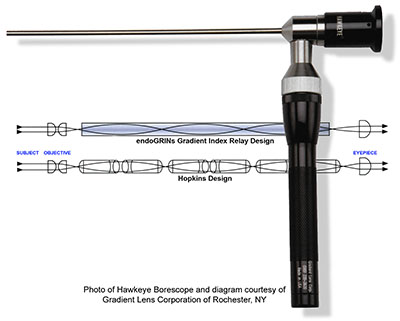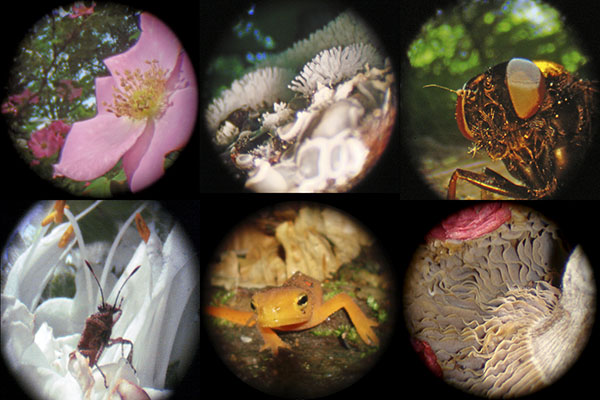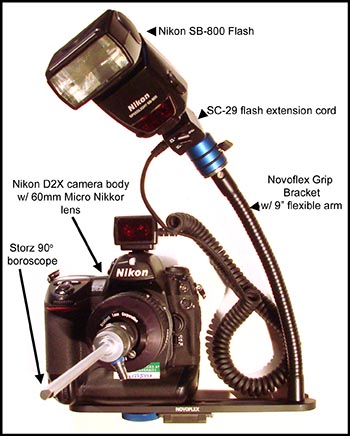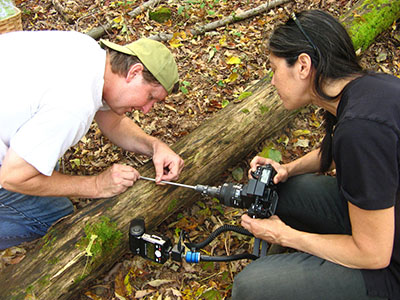The Borescope
Borescopes are curious lenses indeed. Rigid borescopes are long tubes containing either a multiple
lens system (Hopkins design) or a single tubular lens (endoGRINs Gradient Index Relay). On one
end of the tube is a focusing eyepiece and on the other end is an objective lens. The objective lens is
set to view straight ahead (0º Direction of View) or at a 90 degree angle (90º DOV). It may be manufactured to produce a different Field of View from very wide angle (90º FOV) to a much narrower
view (40º FOV). Borescopes are manufactured with a fiber optic channel running from an entrance
port near the eyepiece to an exit port located adjacent to the objective lens. A light source attached to the entrance port will illuminate anything the scope is pointed at, even inside a deep enclosed cavity.
Flexible borescopes are composed of densely packed fiber optic bundles between an objective
lens and eyepiece. These scopes are used to snake into and view hard to reach places such as jet engines or body cavities. The resolution of these flexible scopes is limited, however, to the number of fiber optic tubes of which they are composed, and this resolution is much less than that of a rigid borescope.
After mulling over all the possibilities, I purchased a wide angle (90º FOV), right angle (90º DOV),
rigid borescope with camera adapter, light source, and point and shoot digital camera back. This wide FOV lens would create the "fisheye lens on the end of a stick" imaging device we sought.
Problems and Solutions
Working with the borescope in the field to produce high quality digital images presented numerous
technical challenges. First off, I really didn't like the quality of the images obtained with the point
and shoot camera system that came with the borescope. This camera produced beautiful colors but
the autofocus system it employed did not provide sharp, critical focus when used with the borescope.
Secondly, so little light passes through the borescope to the camera that I found natural light exposures
were too long for hand holding in the field. Using a tripod to steady the camera during these
long exposures was possible, but proved to be quite clumsy, especially when trying to photograph
newts, insects, or tiny mushrooms close to the ground. Electronic flash solved this problem, but the
on-camera flash of the point and shoot camera did not always illuminate the subject properly. Here
are a few examples from these early trials:

 To improve the quality of the imaging system I next adapted the borescope to a digital SLR camera (Nikon D2X) and experimented with different Nikkor lenses and illumination systems. After much trial and error this is the system that eventually proved to work beautifully with
To improve the quality of the imaging system I next adapted the borescope to a digital SLR camera (Nikon D2X) and experimented with different Nikkor lenses and illumination systems. After much trial and error this is the system that eventually proved to work beautifully with
the borescope. The camera and TTL flash are mounted on a bracket with flexible arm for positioning the flash. A
60mm Micro-Nikkor lens is connected to the borescope with a special adapter from the borescope
manufacturer. The auto-focus function of the camera does not work properly with the borescope
so the lens is set to manual, infinity, and wide open (f/2.8) aperture. Focusing is accomplished by
rotating the focusing ring on the borescope itself. ISO is set to 400 and the shutter speed to 1/20th
second. The flash provides the main illumination on the subject and the long shutter time fills in the
background of the deep forest. Instead of a tripod, I found that a beanbag worked well to steady the
system close to the ground for the long exposures.
 Kent Loeffler and Noni Korf
Kent Loeffler and Noni Korf
Vidal using the borescope
to photograph tiny cup
fungi in Shindagin Hollow,
Brooktondale, NY.
